MITSUBISHI GRANDIS 2010 (in English) Repair Manual
Manufacturer: MITSUBISHI, Model Year: 2010, Model line: GRANDIS, Model: MITSUBISHI GRANDIS 2010Pages: 273, PDF Size: 21.01 MB
Page 61 of 273
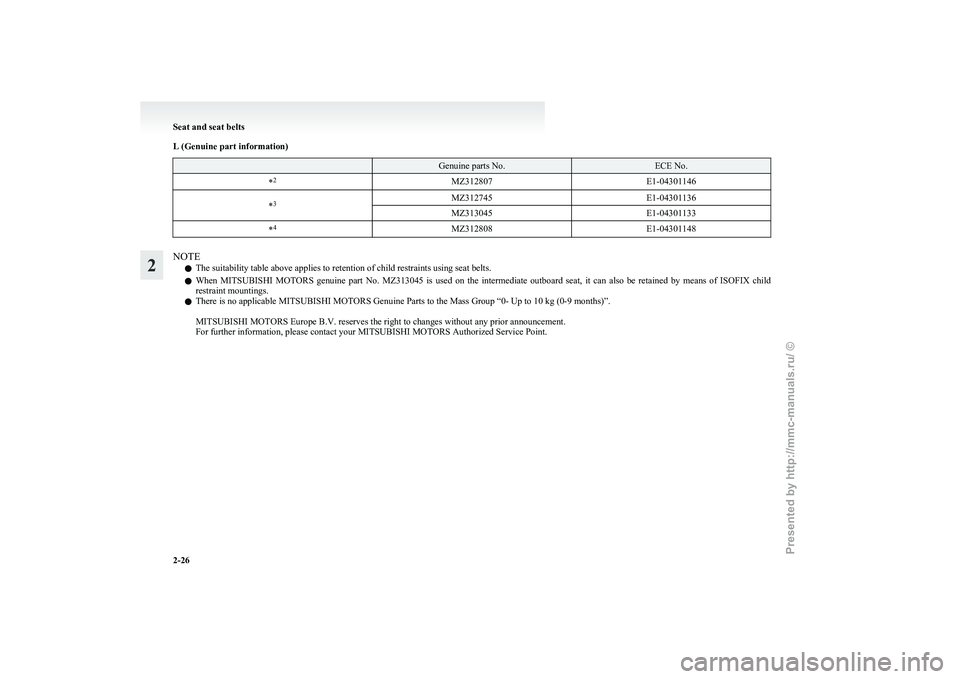
L (Genuine part information)
Genuine parts No. ECE No.
* 2
MZ312807 E1-04301146
* 3 MZ312745
E1-04301136
MZ313045 E1-04301133
* 4
MZ312808 E1-04301148NOTE
l The suitability table above applies to retention of child restraints using seat belts.
l When MITSUBISHI MOTORS
genuine part No. MZ313045 is used on the intermediate outboard seat, it can also be retained by means of ISOFIX child
restraint mountings.
l There is no applicable MITSUBISHI MOTORS Genuine Parts to the Mass Group “0- Up to 10 kg (0-9 months)”.
MITSUBISHI MOTORS Europe B.V. reserves the right to changes without any prior announcement.
For further information, please contact your MITSUBISHI MOTORS Authorized Service Point. Seat and seat belts
2-26
2
Presented by http://mmc-manuals.ru/ \251
Page 62 of 273
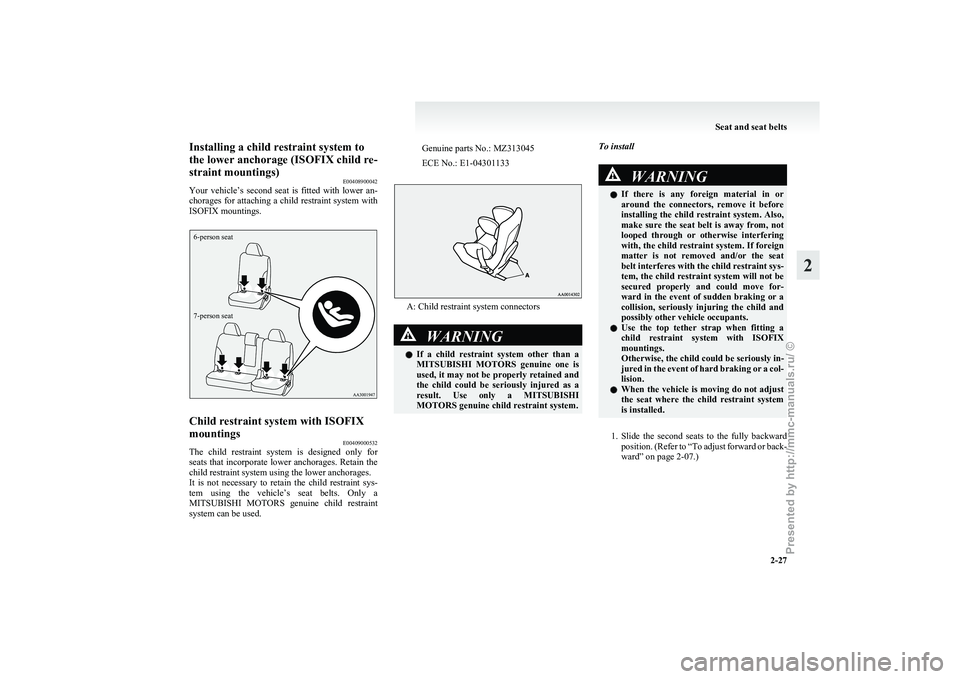
Installing a child restraint system to
the lower anchorage (ISOFIX child re-
straint mountings)
E00408900042
Your
vehicle’s second seat is fitted with lower an-
chorages for attaching a child restraint system with
ISOFIX mountings.
6-person seat
7-person seat Child restraint system with ISOFIX
mountings
E00409000532
The child restraint system is designed only for
seats
that incorporate lower anchorages. Retain the
child restraint system using the lower anchorages.
It is not necessary to retain the child restraint sys-
tem using the vehicle’s seat belts. Only a
MITSUBISHI MOTORS genuine child restraint
system can be used.
Genuine parts No.: MZ313045
ECE No.: E1-04301133
A: Child restraint system connectors
WARNING
l If
a child restraint system other than a
MITSUBISHI MOTORS genuine one is
used, it may not be properly retained and
the child could be seriously injured as a
result. Use only a MITSUBISHI
MOTORS genuine child restraint system. To install WARNING
l If
there is any foreign material in or
around the connectors, remove it before
installing the child restraint system. Also,
make sure the seat belt is away from, not
looped through or otherwise interfering
with, the child restraint system. If foreign
matter is not removed and/or the seat
belt interferes with the child restraint sys-
tem, the child restraint system will not be
secured properly and could move for-
ward in the event of sudden braking or a
collision, seriously injuring the child and
possibly other vehicle occupants.
l Use the top tether strap when fitting a
child restraint system with ISOFIX
mountings.
Otherwise, the child could be seriously in-
jured in the event of hard braking or a col-
lision.
l When the vehicle is moving do not adjust
the seat where the child restraint system
is installed.
1. Slide
the second seats to the fully backward position. (Refer to “To adjust forward or back-
ward” on page 2-07.) Seat and seat belts
2-27 2
Presented by http://mmc-manuals.ru/ \251
Page 63 of 273
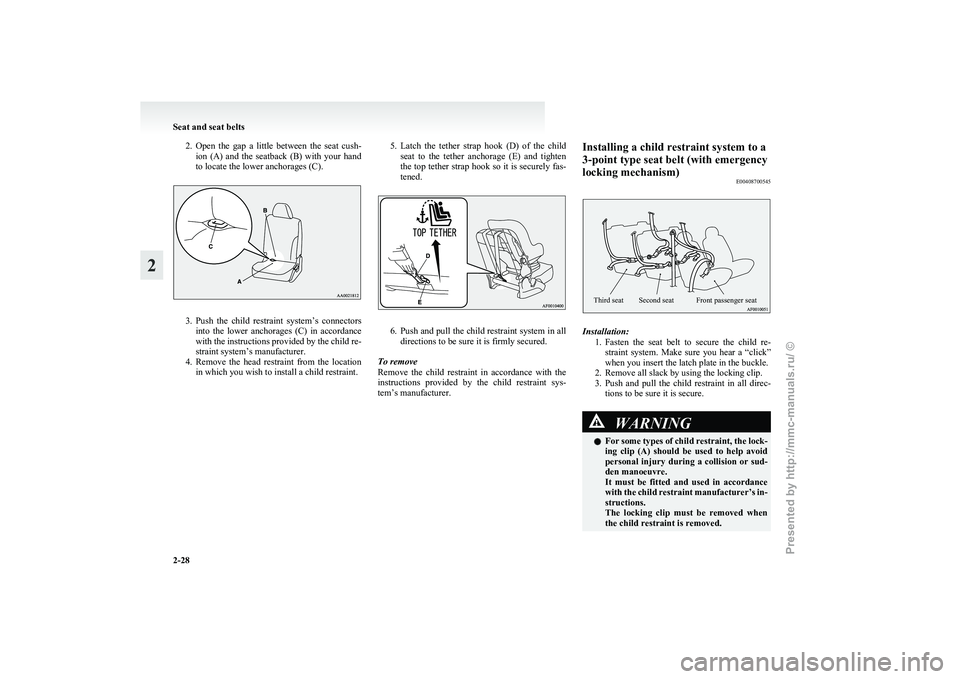
2. Open the gap a little between the seat cush-
ion (A) and the seatback (B) with your hand
to locate the lower anchorages (C). 3. Push
the child restraint system’s connectors
into the lower anchorages (C) in accordance
with the instructions provided by the child re-
straint system’s manufacturer.
4. Remove the head restraint from the location in which you wish to install a child restraint. 5. Latch
the tether strap hook (D) of the child
seat to the tether anchorage (E) and tighten
the top tether strap hook so it is securely fas-
tened. 6. Push
and pull the child restraint system in all
directions to be sure it is firmly secured.
To remove
Remove the child restraint in accordance with the
instructions provided by the child restraint sys-
tem’s manufacturer. Installing a child restraint system to a
3-point type seat belt (with emergency
locking mechanism)
E00408700545
Third seat Second seat Front passenger seat Installation:
1. Fasten
the seat belt to secure the child re-
straint system. Make sure you hear a “click”
when you insert the latch plate in the buckle.
2. Remove all slack by using the locking clip.
3. Push and pull the child restraint in all direc- tions to be sure it is secure. WARNING
l For
some types of child restraint, the lock-
ing clip (A) should be used to help avoid
personal injury during a collision or sud-
den manoeuvre.
It must be fitted and used in accordance
with the child restraint manufacturer’s in-
structions.
The locking clip must be removed when
the child restraint is removed. Seat and seat belts
2-28
2
Presented by http://mmc-manuals.ru/ \251
Page 64 of 273
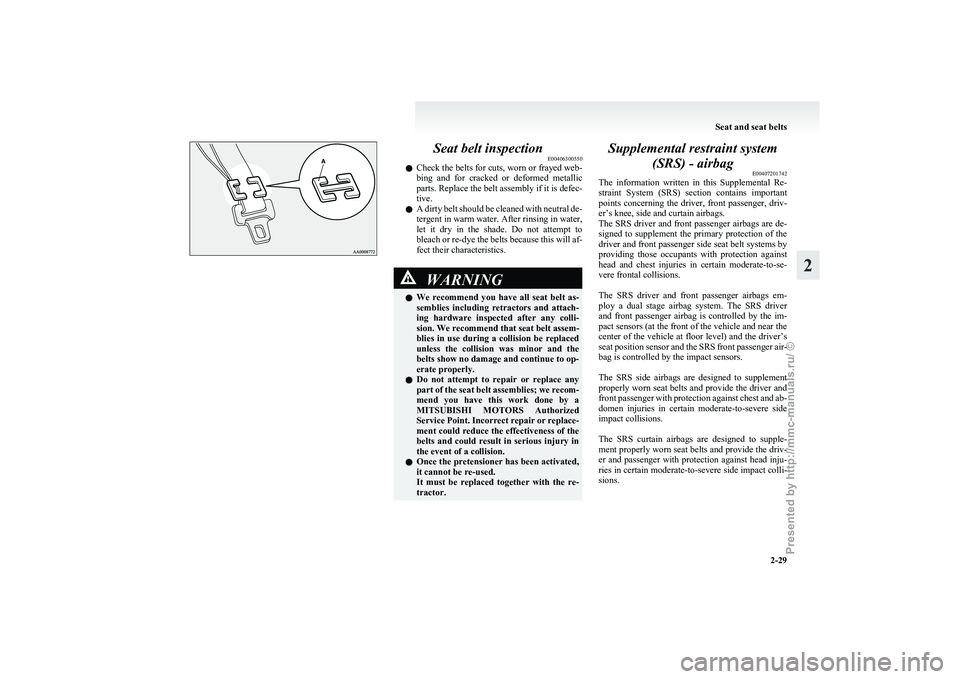
Seat belt inspection
E00406300550
l Check
the belts for cuts, worn or frayed web-
bing and for cracked or deformed metallic
parts. Replace the belt assembly if it is defec-
tive.
l A dirty belt should be cleaned with neutral de-
tergent in warm water. After rinsing in water,
let it dry in the shade. Do not attempt to
bleach or re-dye the belts because this will af-
fect their characteristics. WARNING
l We
recommend you have all seat belt as-
semblies including retractors and attach-
ing hardware inspected after any colli-
sion. We recommend that seat belt assem-
blies in use during a collision be replaced
unless the collision was minor and the
belts show no damage and continue to op-
erate properly.
l Do not attempt to repair or replace any
part of the seat belt assemblies; we recom-
mend you have this work done by a
MITSUBISHI MOTORS Authorized
Service Point. Incorrect repair or replace-
ment could reduce the effectiveness of the
belts and could result in serious injury in
the event of a collision.
l Once the pretensioner has been activated,
it cannot be re-used.
It must be replaced together with the re-
tractor. Supplemental restraint system
(SRS) - airbag E00407201742
The
information written in this Supplemental Re-
straint System (SRS) section contains important
points concerning the driver, front passenger, driv-
er’s knee, side and curtain airbags.
The SRS driver and front passenger airbags are de-
signed to supplement the primary protection of the
driver and front passenger side seat belt systems by
providing those occupants with protection against
head and chest injuries in certain moderate-to-se-
vere frontal collisions.
The SRS driver and front passenger airbags em-
ploy a dual stage airbag system. The SRS driver
and front passenger airbag is controlled by the im-
pact sensors (at the front of the vehicle and near the
center of the vehicle at floor level) and the driver’s
seat position sensor and the SRS front passenger air-
bag is controlled by the impact sensors.
The SRS side airbags are designed to supplement
properly worn seat belts and provide the driver and
front passenger with protection against chest and ab-
domen injuries in certain moderate-to-severe side
impact collisions.
The SRS curtain airbags are designed to supple-
ment properly worn seat belts and provide the driv-
er and passenger with protection against head inju-
ries in certain moderate-to-severe side impact colli-
sions.
Seat and seat belts
2-29 2
Presented by http://mmc-manuals.ru/ \251
Page 65 of 273
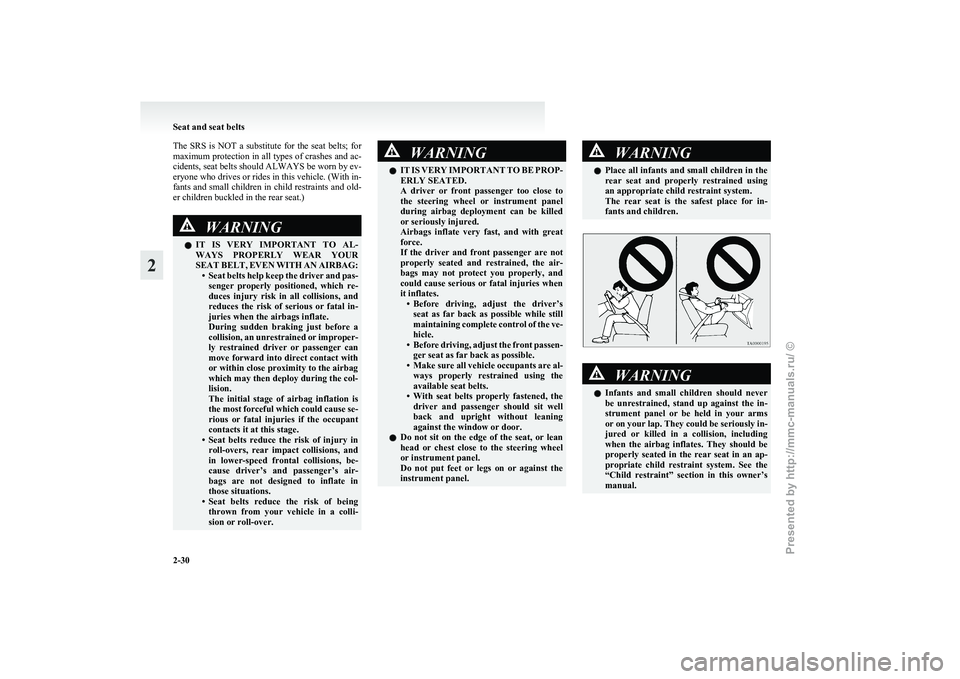
The SRS is NOT a substitute for the seat belts; for
maximum
protection in all types of crashes and ac-
cidents, seat belts should ALWAYS be worn by ev-
eryone who drives or rides in this vehicle. (With in-
fants and small children in child restraints and old-
er children buckled in the rear seat.) WARNING
l IT
IS VERY IMPORTANT TO AL-
WAYS PROPERLY WEAR YOUR
SEAT BELT, EVEN WITH AN AIRBAG: • Seat belts help keep the driver and pas-senger properly positioned, which re-
duces injury risk in all collisions, and
reduces the risk of serious or fatal in-
juries when the airbags inflate.
During sudden braking just before a
collision, an unrestrained or improper-
ly restrained driver or passenger can
move forward into direct contact with
or within close proximity to the airbag
which may then deploy during the col-
lision.
The initial stage of airbag inflation is
the most forceful which could cause se-
rious or fatal injuries if the occupant
contacts it at this stage.
• Seat belts reduce the risk of injury in roll-overs, rear impact collisions, and
in lower-speed frontal collisions, be-
cause driver’s and passenger’s air-
bags are not designed to inflate in
those situations.
• Seat belts reduce the risk of being thrown from your vehicle in a colli-
sion or roll-over. WARNING
l IT
IS VERY IMPORTANT TO BE PROP-
ERLY SEATED.
A driver or front passenger too close to
the steering wheel or instrument panel
during airbag deployment can be killed
or seriously injured.
Airbags inflate very fast, and with great
force.
If the driver and front passenger are not
properly seated and restrained, the air-
bags may not protect you properly, and
could cause serious or fatal injuries when
it inflates. • Before driving, adjust the driver’sseat as far back as possible while still
maintaining complete control of the ve-
hicle.
• Before driving, adjust the front passen- ger seat as far back as possible.
• Make sure all vehicle occupants are al- ways properly restrained using the
available seat belts.
• With seat belts properly fastened, the driver and passenger should sit well
back and upright without leaning
against the window or door.
l Do not sit on the edge of the seat, or lean
head or chest close to the steering wheel
or instrument panel.
Do not put feet or legs on or against the
instrument panel. WARNING
l Place all infants and small children in the
rear seat and properly restrained using
an appropriate child restraint system.
The rear seat is the safest place for in-
fants and children. WARNING
l Infants
and small children should never
be unrestrained, stand up against the in-
strument panel or be held in your arms
or on your lap. They could be seriously in-
jured or killed in a collision, including
when the airbag inflates. They should be
properly seated in the rear seat in an ap-
propriate child restraint system. See the
“Child restraint” section in this owner’s
manual. Seat and seat belts
2-30
2
Presented by http://mmc-manuals.ru/ \251
Page 66 of 273
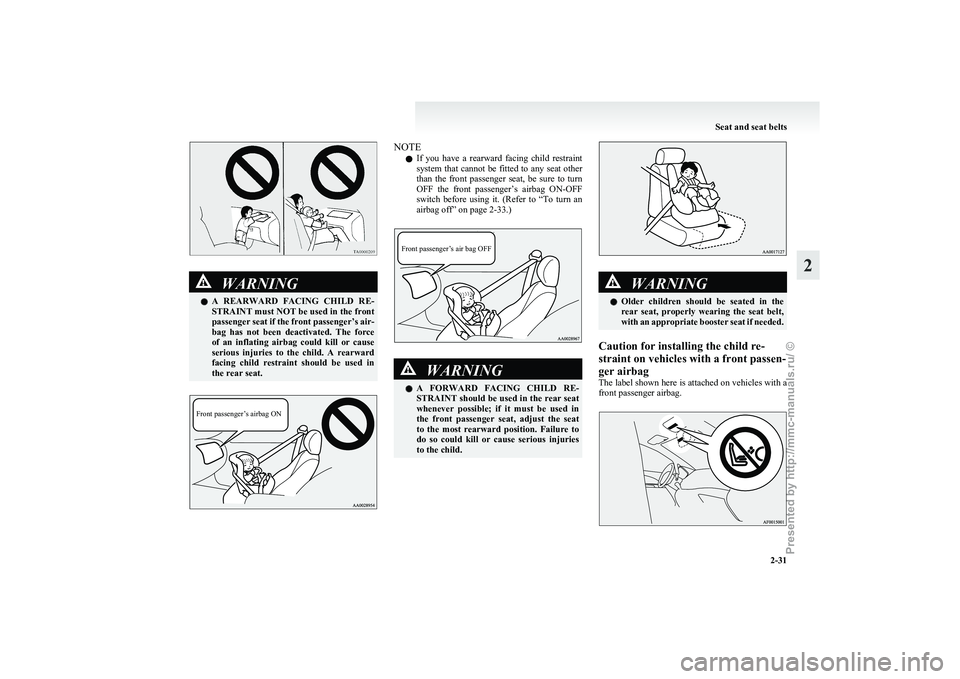
WARNING
l A REARWARD FACING CHILD RE-
STRAINT must NOT be used in the front
passenger seat if the front passenger’s air-
bag has not been deactivated. The force
of an inflating airbag could kill or cause
serious injuries to the child. A rearward
facing child restraint should be used in
the rear seat.
Front passenger’s airbag ON NOTE
l If
you have a rearward facing child restraint
system that cannot be fitted to any seat other
than the front passenger seat, be sure to turn
OFF the front passenger’s airbag ON-OFF
switch before using it. (Refer to “To turn an
airbag off” on page 2-33.)
Front passenger’s air bag OFF WARNING
l A
FORWARD FACING CHILD RE-
STRAINT should be used in the rear seat
whenever possible; if it must be used in
the front passenger seat, adjust the seat
to the most rearward position. Failure to
do so could kill or cause serious injuries
to the child. WARNING
l Older
children should be seated in the
rear seat, properly wearing the seat belt,
with an appropriate booster seat if needed.
Caution for installing the child re-
straint on vehicles with a front passen-
ger airbag
The
label shown here is attached on vehicles with a
front passenger airbag. Seat and seat belts
2-31 2
Presented by http://mmc-manuals.ru/ \251
Page 67 of 273
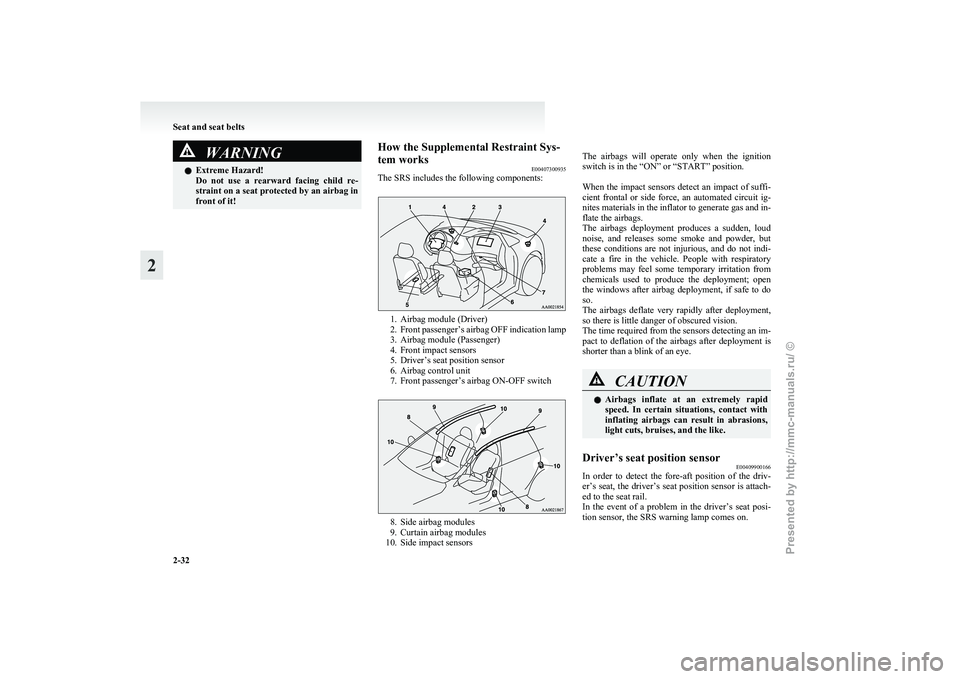
WARNING
l Extreme Hazard!
Do
not use a rearward facing child re-
straint on a seat protected by an airbag in
front of it! How the Supplemental Restraint Sys-
tem works
E00407300935
The SRS includes the following components: 1. Airbag module (Driver)
2. Front
passenger’s airbag OFF indication lamp
3. Airbag module (Passenger)
4. Front impact sensors
5. Driver’s seat position sensor
6. Airbag control unit
7. Front passenger’s airbag ON-OFF switch 8. Side airbag modules
9.
Curtain airbag modules
10. Side impact sensors
The
airbags will operate only when the ignition
switch is in the “ON” or “START” position.
When the impact sensors detect an impact of suffi-
cient frontal or side force, an automated circuit ig-
nites materials in the inflator to generate gas and in-
flate the airbags.
The airbags deployment produces a sudden, loud
noise, and releases some smoke and powder, but
these conditions are not injurious, and do not indi-
cate a fire in the vehicle. People with respiratory
problems may feel some temporary irritation from
chemicals used to produce the deployment; open
the windows after airbag deployment, if safe to do
so.
The airbags deflate very rapidly after deployment,
so there is little danger of obscured vision.
The time required from the sensors detecting an im-
pact to deflation of the airbags after deployment is
shorter than a blink of an eye. CAUTION
l
Airbags
inflate at an extremely rapid
speed. In certain situations, contact with
inflating airbags can result in abrasions,
light cuts, bruises, and the like.
Driver’s seat position sensor E00409900166
In order to detect the fore-aft position of the driv-
er’s
seat, the driver’s seat position sensor is attach-
ed to the seat rail.
In the event of a problem in the driver’s seat posi-
tion sensor, the SRS warning lamp comes on. Seat and seat belts
2-32
2
Presented by http://mmc-manuals.ru/ \251
Page 68 of 273
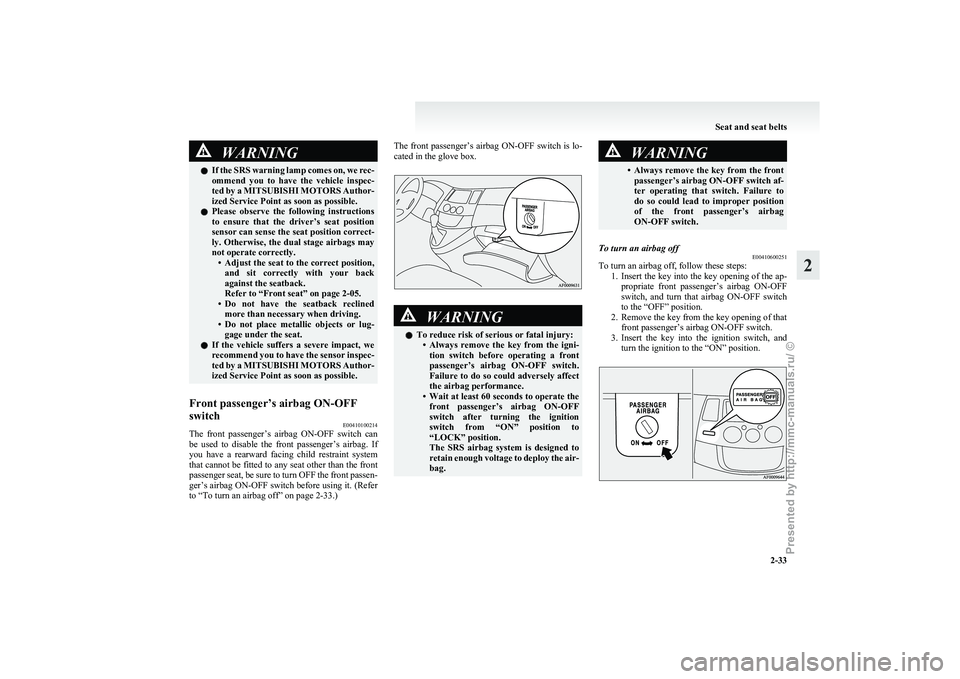
WARNING
l If the SRS warning lamp comes on, we rec-
ommend you to have the vehicle inspec-
ted by a MITSUBISHI MOTORS Author-
ized Service Point as soon as possible.
l Please observe the following instructions
to ensure that the driver’s seat position
sensor can sense the seat position correct-
ly. Otherwise, the dual stage airbags may
not operate correctly.
• Adjust the seat to the correct position,and sit correctly with your back
against the seatback.
Refer to “Front seat” on page 2-05.
• Do not have the seatback reclined more than necessary when driving.
• Do not place metallic objects or lug- gage under the seat.
l If the vehicle suffers a severe impact, we
recommend you to have the sensor inspec-
ted by a MITSUBISHI MOTORS Author-
ized Service Point as soon as possible.
Front passenger’s airbag ON-OFF
switch E00410100214
The front passenger’s airbag ON-OFF
switch can
be used to disable the front passenger’s airbag. If
you have a rearward facing child restraint system
that cannot be fitted to any seat other than the front
passenger seat, be sure to turn OFF the front passen-
ger’s airbag ON-OFF switch before using it. (Refer
to “To turn an airbag off” on page 2-33.) The front passenger’s airbag ON-OFF
switch is lo-
cated in the glove box. WARNING
l To reduce risk of serious or fatal injury:
• Always
remove the key from the igni-
tion switch before operating a front
passenger’s airbag ON-OFF switch.
Failure to do so could adversely affect
the airbag performance.
• Wait at least 60 seconds to operate the front passenger’s airbag ON-OFF
switch after turning the ignition
switch from “ON” position to
“LOCK” position.
The SRS airbag system is designed to
retain enough voltage to deploy the air-
bag. WARNING
• Always
remove the key from the front passenger’s airbag ON-OFF switch af-
ter operating that switch. Failure to
do so could lead to improper position
of the front passenger’s airbag
ON-OFF switch.
To turn an airbag off E00410600251
To turn an airbag off, follow these steps:
1. Insert
the key into the key opening of the ap-
propriate front passenger’s airbag ON-OFF
switch, and turn that airbag ON-OFF switch
to the “OFF” position.
2. Remove the key from the key opening of that front passenger’s airbag ON-OFF switch.
3. Insert the key into the ignition switch, and turn the ignition to the “ON” position. Seat and seat belts
2-33 2
Presented by http://mmc-manuals.ru/ \251
Page 69 of 273
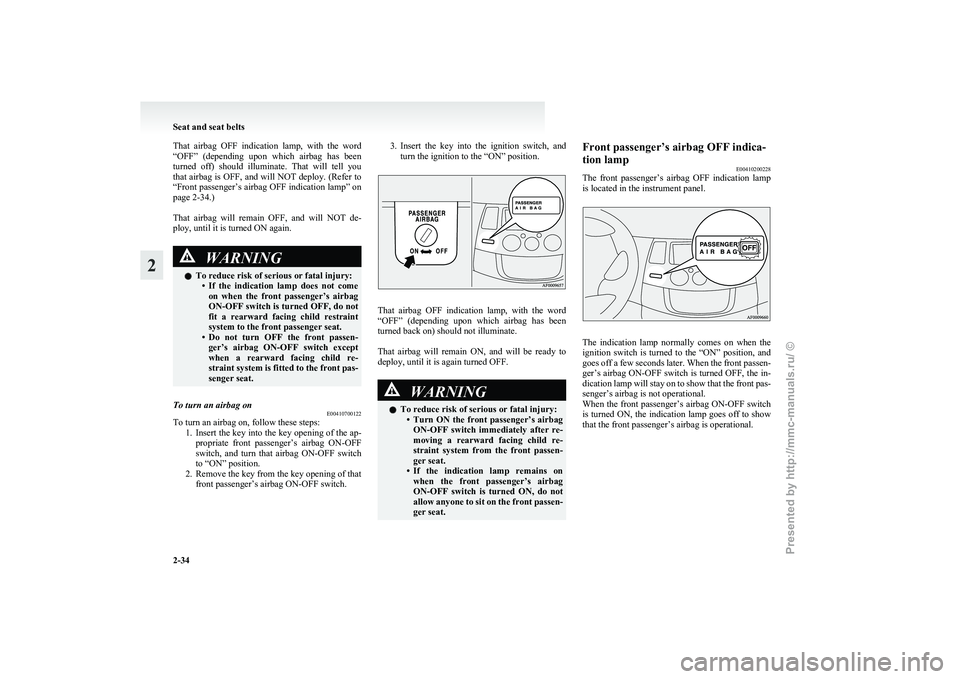
That airbag OFF indication lamp, with the word
“OFF”
(depending upon which airbag has been
turned off) should illuminate. That will tell you
that airbag is OFF, and will NOT deploy. (Refer to
“Front passenger’s airbag OFF indication lamp” on
page 2-34.)
That airbag will remain OFF, and will NOT de-
ploy, until it is turned ON again. WARNING
l To reduce risk of serious or fatal injury:
• If
the indication lamp does not come
on when the front passenger’s airbag
ON-OFF switch is turned OFF, do not
fit a rearward facing child restraint
system to the front passenger seat.
• Do not turn OFF the front passen- ger’s airbag ON-OFF switch except
when a rearward facing child re-
straint system is fitted to the front pas-
senger seat.
To turn an airbag on E00410700122
To turn an airbag on, follow these steps:
1. Insert
the key into the key opening of the ap-
propriate front passenger’s airbag ON-OFF
switch, and turn that airbag ON-OFF switch
to “ON” position.
2. Remove the key from the key opening of that front passenger’s airbag ON-OFF switch. 3. Insert
the key into the ignition switch, and
turn the ignition to the “ON” position. That airbag OFF indication lamp, with the word
“OFF”
(depending upon which airbag has been
turned back on) should not illuminate.
That airbag will remain ON, and will be ready to
deploy, until it is again turned OFF. WARNING
l To reduce risk of serious or fatal injury:
• Turn
ON the front passenger’s airbag
ON-OFF switch immediately after re-
moving a rearward facing child re-
straint system from the front passen-
ger seat.
• If the indication lamp remains on when the front passenger’s airbag
ON-OFF switch is turned ON, do not
allow anyone to sit on the front passen-
ger seat. Front passenger’s airbag OFF indica-
tion lamp
E00410200228
The
front passenger’s airbag OFF indication lamp
is located in the instrument panel. The indication lamp normally comes on when the
ignition
switch is turned to the “ON” position, and
goes off a few seconds later. When the front passen-
ger’s airbag ON-OFF switch is turned OFF, the in-
dication lamp will stay on to show that the front pas-
senger’s airbag is not operational.
When the front passenger’s airbag ON-OFF switch
is turned ON, the indication lamp goes off to show
that the front passenger’s airbag is operational. Seat and seat belts
2-34
2
Presented by http://mmc-manuals.ru/ \251
Page 70 of 273
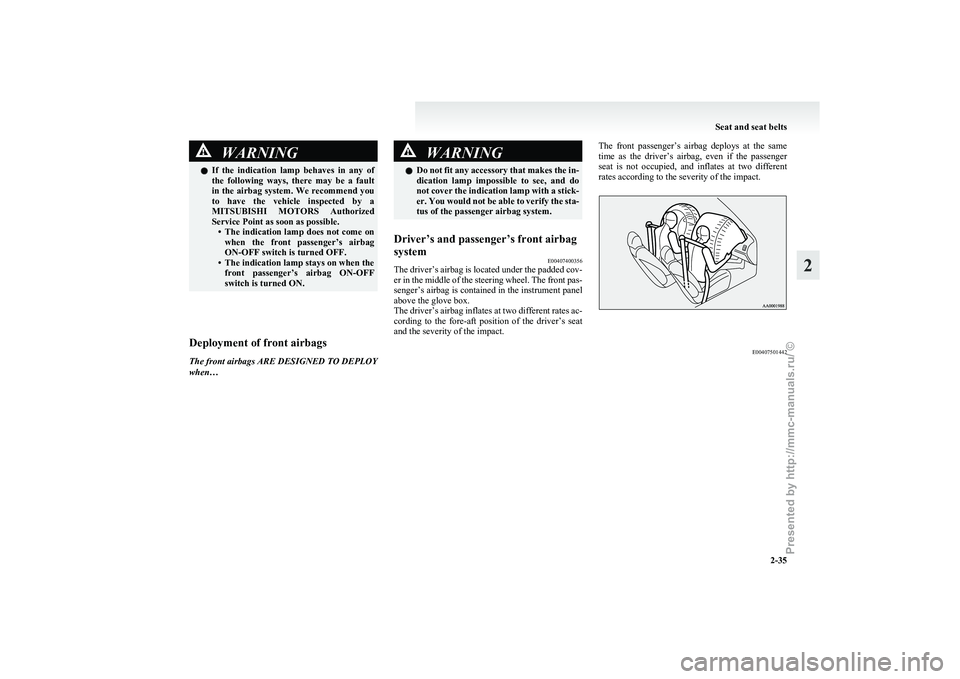
WARNING
l If the indication lamp behaves in any of
the following ways, there may be a fault
in the airbag system. We recommend you
to have the vehicle inspected by a
MITSUBISHI MOTORS Authorized
Service Point as soon as possible. • The indication lamp does not come onwhen the front passenger’s airbag
ON-OFF switch is turned OFF.
• The indication lamp stays on when the front passenger’s airbag ON-OFF
switch is turned ON. WARNING
l Do not fit any accessory that makes the in-
dication lamp impossible to see, and do
not cover the indication lamp with a stick-
er. You would not be able to verify the sta-
tus of the passenger airbag system.
Driver’s and passenger’s front airbag
system E00407400356
The driver’s airbag is located under the padded cov-
er
in the middle of the steering wheel. The front pas-
senger’s airbag is contained in the instrument panel
above the glove box.
The driver’s airbag inflates at two different rates ac-
cording to the fore-aft position of the driver’s seat
and the severity of the impact. The front passenger’s airbag deploys at the same
time
as the driver’s airbag, even if the passenger
seat is not occupied, and inflates at two different
rates according to the severity of the impact. Deployment of front airbags
E00407501442
The front airbags ARE DESIGNED TO DEPLOY
when… Seat and seat belts
2-35 2
Presented by http://mmc-manuals.ru/ \251